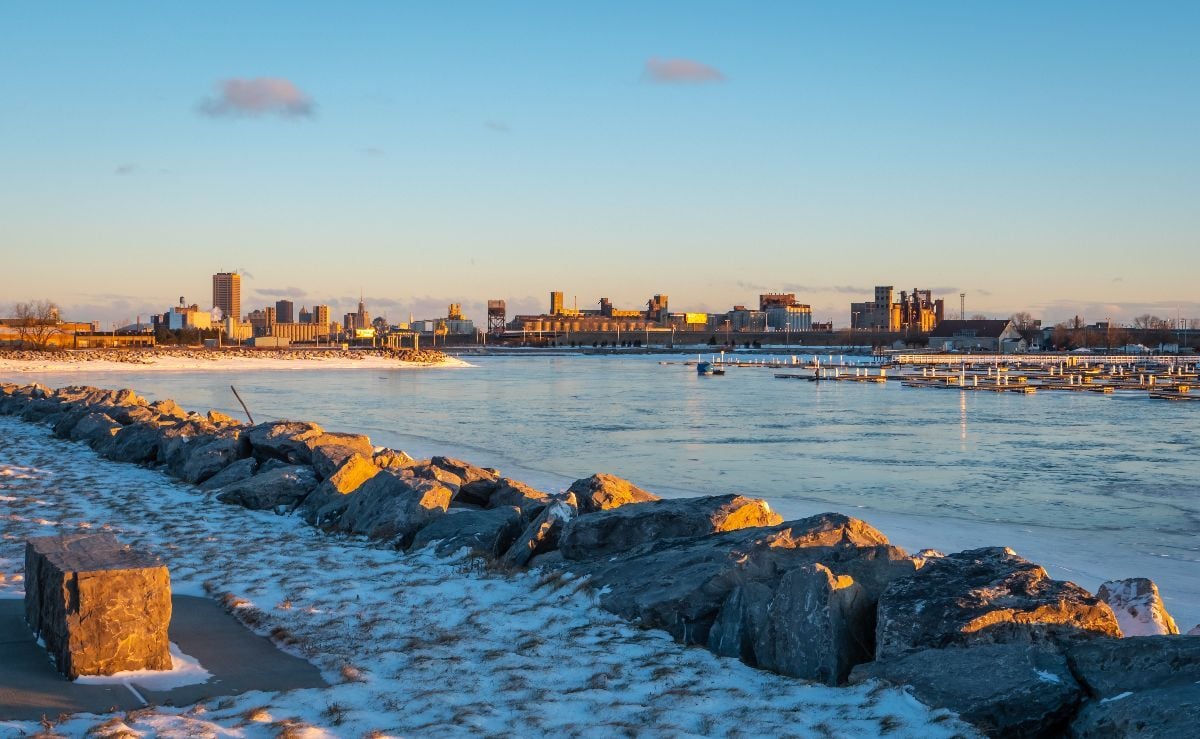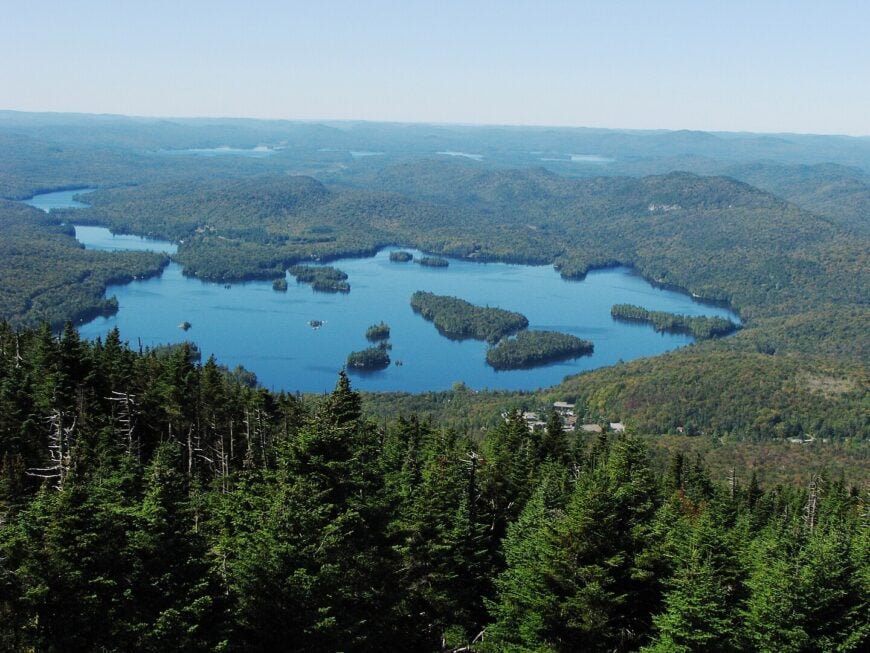
Northern New York shelters a string of small lakeside communities where life still pivots around the water, the woods, and long stretches of quiet. Visitors often find there is no cell service on back roads, no neon signs at crossroads, and no crowds queuing for lattes at dawn.
Instead, there are century-old boathouses, dark-sky nights, and neighbors who double as caretakers when snow piles high. Our guide counts down 25 hamlets that reward those willing to drive a little farther and linger a little longer.
Each offers public lands, protected shorelines, and an easygoing pace that feels almost forgotten. From spacious great camps reachable only by boat to tight-knit villages whose only main street is a footbridge, these places prove that true seclusion still exists within a day’s drive of the Northeast’s busy cities.
25. Fine, St. Lawrence County
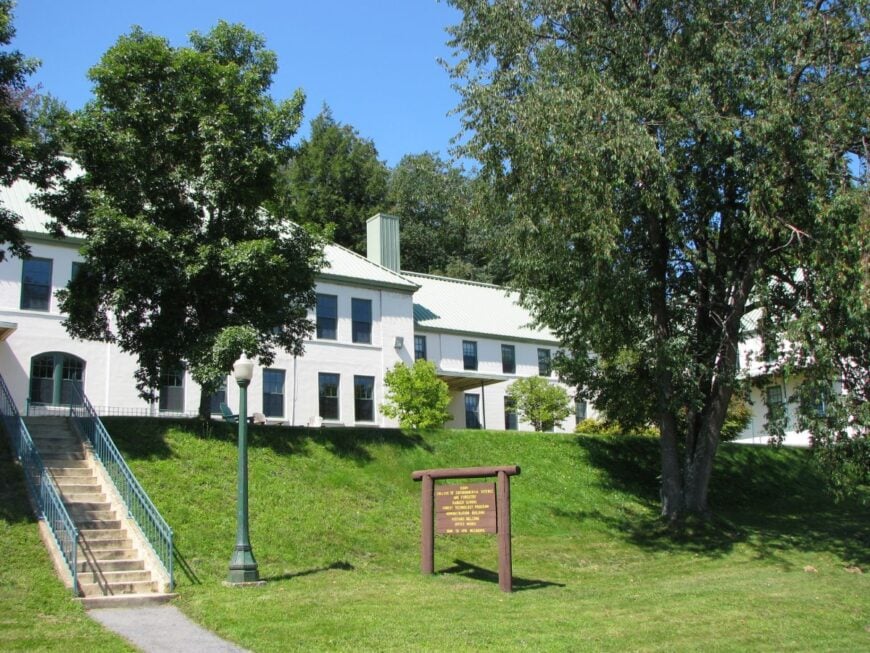
Fine is a quiet hamlet spread along the Oswegatchie River, where pine forests and winding water create a sense of being far from anywhere. Fewer than 1,500 people live in the entire township, with homes tucked into clearings and along old logging roads.
The air carries the scent of spruce, and the only rush-hour traffic might be a pair of deer crossing Main Street. Visitors come to paddle the calm stretches of the river, hike in nearby Five Ponds Wilderness, or stop at the century-old general store.
Small-scale forestry and seasonal tourism keep the economy modest but steady. Winter wraps Fine in deep snow, muting even the few passing cars. It’s a place where the days feel long and the nights are ink-dark and star-filled.
Where is Fine?
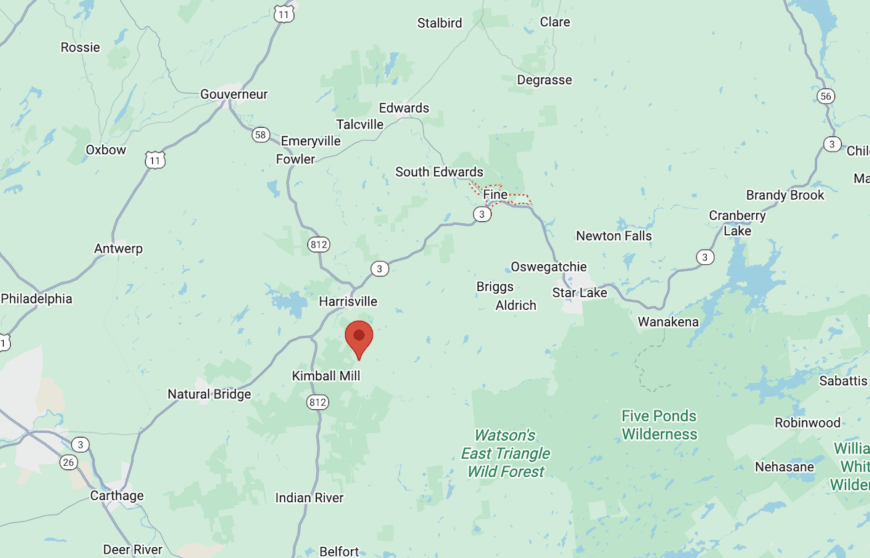
Fine lies in the western Adirondacks along NY-58, about 22 miles southeast of Gouverneur. The road in winds through long stretches of state forest, with little more than trailheads and scattered homesteads along the way.
The nearest larger services are in Gouverneur to the west or Star Lake to the east. Once you arrive, the pine forest seems to fold back in behind you, sealing the hamlet in its own quiet pocket of the Adirondacks.
24. Newton Falls, St. Lawrence County
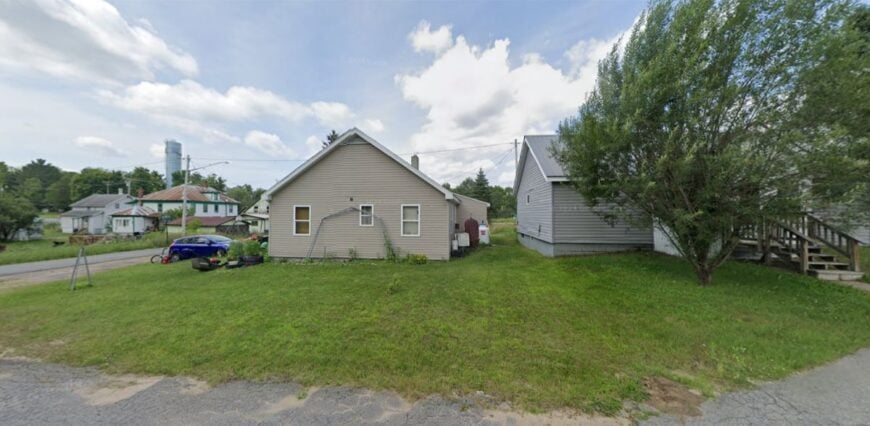
Newton Falls is a former mill town tucked deep into the forest, where the East Branch of the Oswegatchie runs swift and cold. With a population under 500, the hamlet feels almost forgotten except by those who live here.
Visitors find a scattering of clapboard houses, an old post office, and the low hum of the river over granite ledges. The surrounding woods offer miles of trails, and the nearby Tooley Pond Road is famed for its string of scenic waterfalls.
After the paper mill closed, life slowed, leaving the town to logging, guiding, and seasonal fishing traffic. Even in summer, it’s possible to walk Main Street without seeing another soul. The quiet here is not an absence but a presence.
Where is Newton Falls?
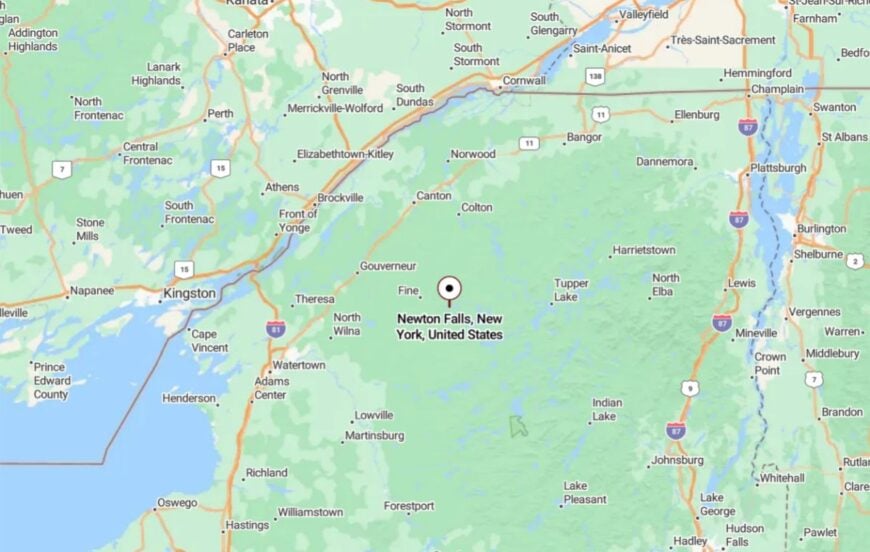
Newton Falls sits in southern St. Lawrence County, about 15 miles south of Star Lake via NY-3 and County Route 60. The approach winds through forest and alongside rivers that seem to bend away from the road.
The nearest grocery store is a half-hour drive, reinforcing its remoteness. Arriving feels like stepping into a clearing that belongs only to the pines.
23. Harrisville, Lewis County
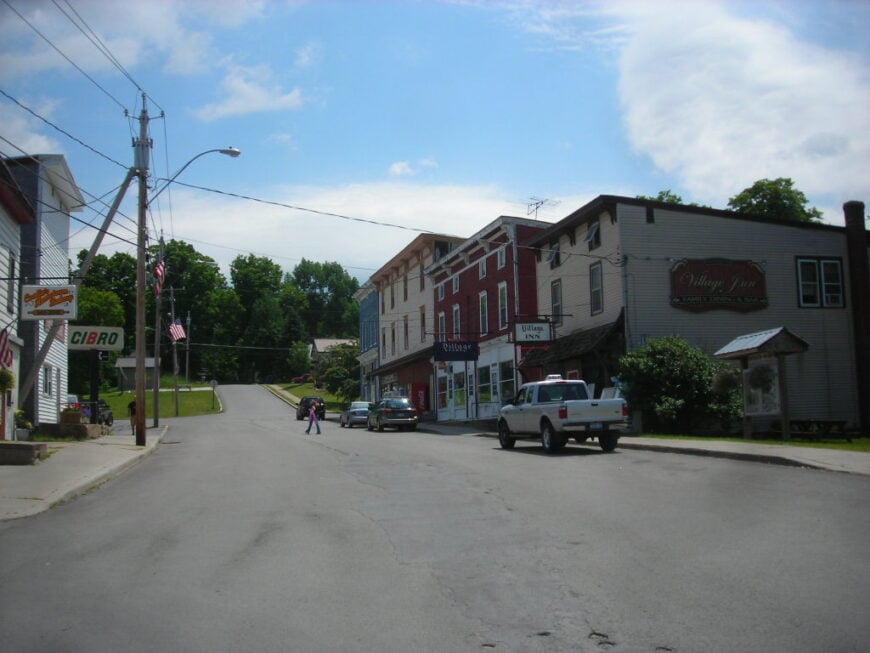
Harrisville is a riverside village that feels like the Adirondacks’ front porch, though the pace is pure backwoods. Around 600 people live here year-round, with life centered on the Oswegatchie River and the old mill dam in the village center.
Locals fish for smallmouth bass, paddle upstream to quiet coves, and swap stories over coffee at the diner. Logging trucks still rumble through, but the forest keeps them muffled once they’re gone.
The main street holds just enough shops to meet daily needs, and nothing more. Fall colors here reflect in both the water and the windows of weathered buildings. It’s the kind of town where time slows down whether you ask it to or not.
Where is Harrisville?
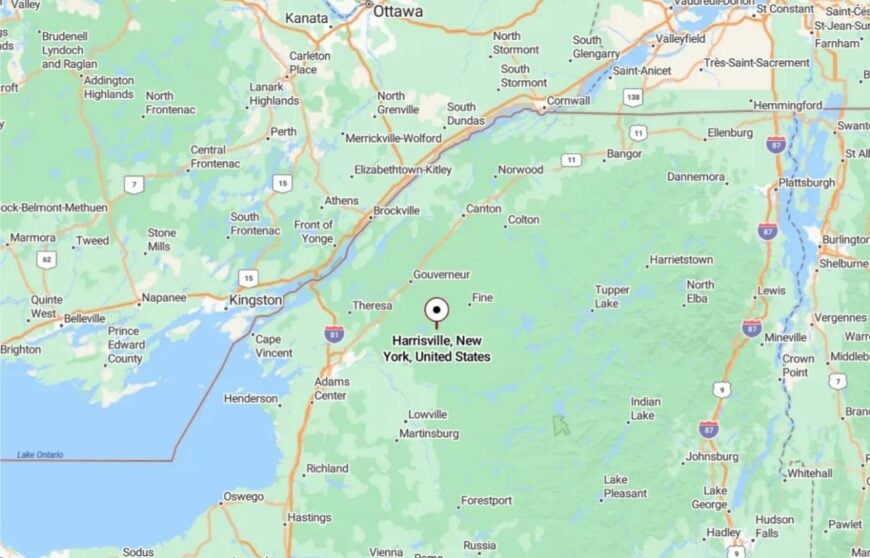
Harrisville is in northern Lewis County, about 18 miles southeast of Gouverneur on NY-3. The drive in follows the river and skirts long stretches of state forest.
The closest larger towns are Carthage to the west and Gouverneur to the north. The wooded approach makes the village feel tucked into its own green fold.
22. Eagle Bay, Hamilton County

Eagle Bay perches quietly on the northern shore of Fourth Lake, a biscuit-shaped inlet suspended between Inlet and Old Forge. Fewer than 200 year-round residents share narrow lanes lined with timber-frame cottages and century-old Adirondack great camps. Pines and hemlocks drape the shore so tightly that each sunrise feels like a private showing over the water.
Life here moves at the glide of a canoe paddle. Visitors drift past mirrored boathouses at dawn, hike the West Mountain trail for panoramic views of the Fulton Chain, or gather at the lone general store for fresh-baked pies and local lore. Even in high season, traffic dissolves by dusk, leaving only loons and porcupines to mark the hour.
The hamlet’s economy leans on seasonal guiding, caretaking gigs at the great camps, and a handful of family-run lodges. Strict zoning caps new construction, so nights fall dark enough to see Orion’s Belt, and the only buzz you hear is from distant fireflies over the shoreline marsh.
Where is Eagle Bay?
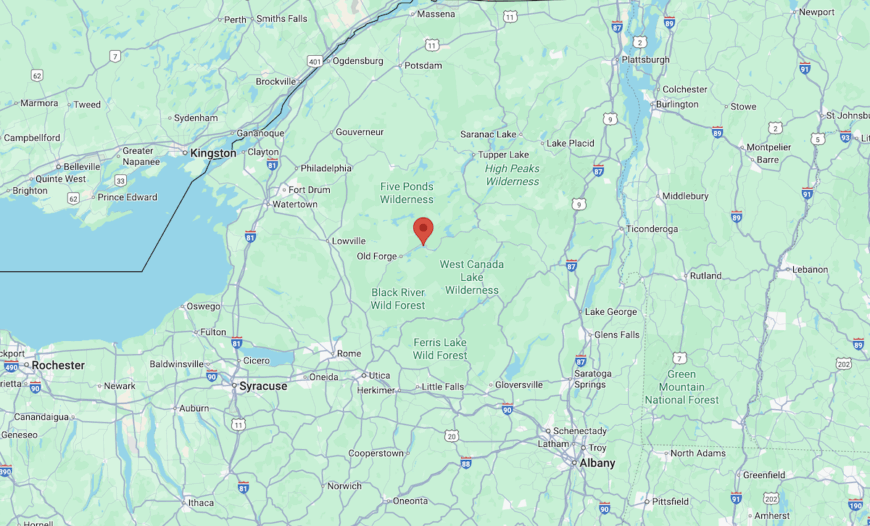
Eagle Bay sits on Fourth Lake in central Hamilton County, straddling NY-28 between Inlet (about five miles west) and Old Forge (about seven miles east). The approach winds beside the lake’s finger inlets, through mixed spruce and maple stands that swallow nearby sightlines.
The nearest grocery and gas station are in Old Forge, while Inlet hosts the closest café and outfitter. Limited cell coverage cements the feel of stepping off the grid—every arrival here feels like a deliberate choice to linger in the woods.
21. Tupper Lake, Franklin County
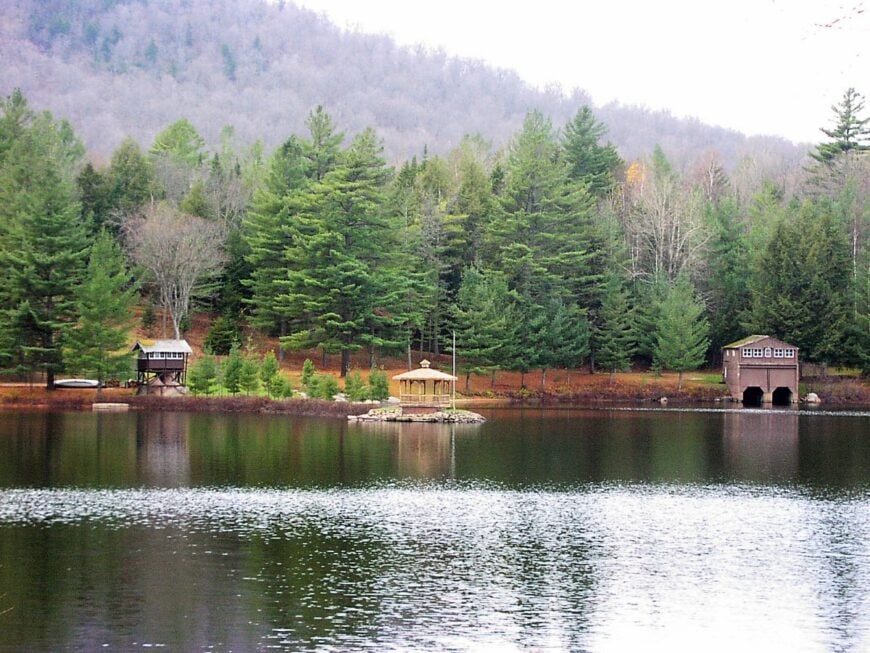
Tupper Lake is larger than most on this list, yet its setting keeps it grounded in seclusion. Surrounded by forested peaks and long stretches of undeveloped shoreline, it offers both wilderness access and a tight-knit community of about 3,500.
Visitors paddle to remote campsites, hike the Mount Arab fire tower trail, or explore The Wild Center’s nature trails. The town’s economy mixes tourism with logging and small manufacturing, but the streets are calm compared to busier Adirondack hubs.
Evening light often turns the water coppery, with loons calling from the far shore. Even with amenities at hand, the wild edges feel just steps away. It’s a balance of comfort and remoteness that’s rare to find.
Where is Tupper Lake?
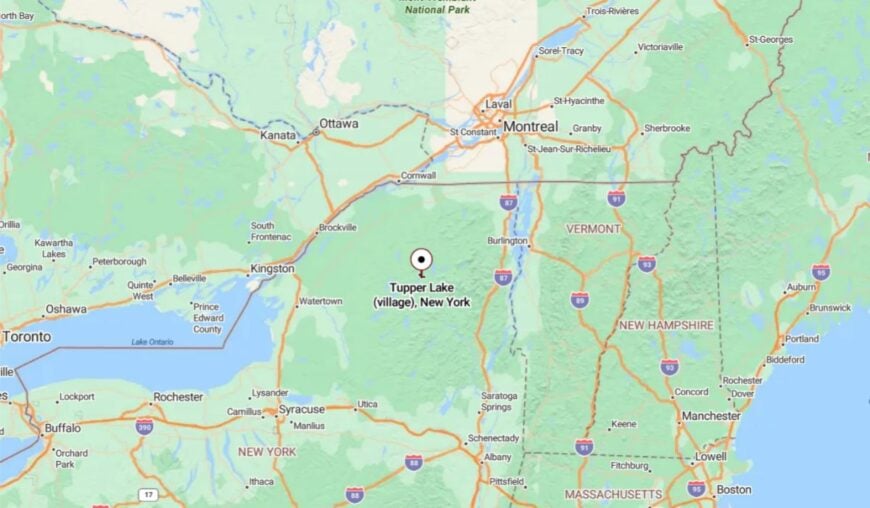
Tupper Lake lies in the central Adirondacks along NY-3 and NY-30, about 30 miles southwest of Saranac Lake. The approach from any direction passes through many miles of Adirondack Forest Preserve. The nearest interstate is more than an hour away. The surrounding wilderness keeps the lake and town feeling well apart from the outside world.
20. Piercefield, St. Lawrence County

Piercefield is a spread-out hamlet where forest roads and river curves guide the layout more than any mapmaker’s lines. Fewer than 300 residents live here, many in houses tucked deep into pine and spruce stands.
Life moves with the seasons: fishing in spring, logging in winter, and quiet evenings on the porch year-round. Visitors come for the Raquette River rapids and the nearby Massawepie Mire, a vast wetland rich with rare birds.
The absence of major businesses means nights are truly dark and mornings are filled only with the sounds of the woods. It’s a place that trades convenience for peace without hesitation.
Where is Piercefield?
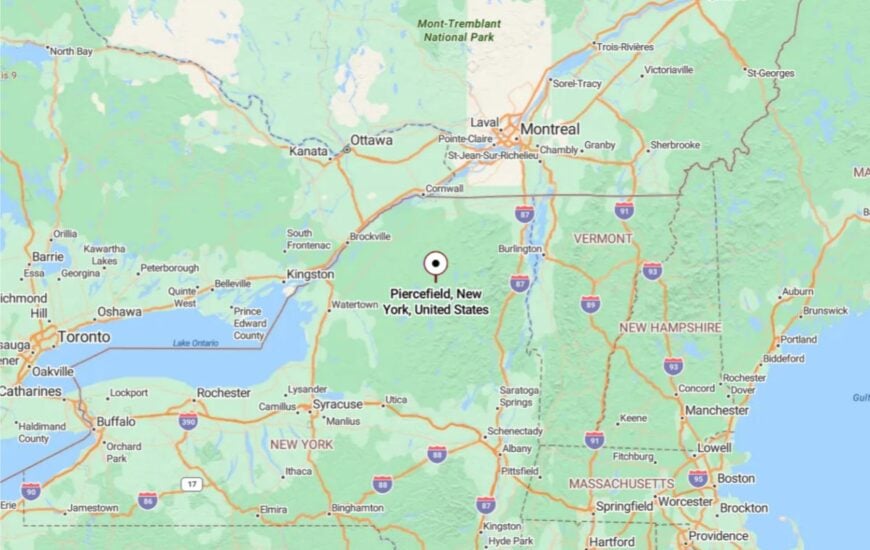
Piercefield is just west of Tupper Lake along NY-3 in St. Lawrence County. The road runs beside the Raquette River for much of the way.
The nearest larger services are in Tupper Lake, about 10 minutes east. Forest and water on both sides of the route keep it feeling isolated.
19. Waddington, St. Lawrence County

Waddington sits quietly on the St. Lawrence River, far from the busy Thousand Islands marinas. About 2,000 residents share a waterfront that feels more like a park than a port.
Anglers prize it for bass tournaments, while locals enjoy riverside picnics and walks along the seawall. The village is laid-back, with a handful of shops and cafés but no chain stores.
Open farmland spreads southward, and the river to the north is dotted with small islands that block the horizon. Evening light on the water turns the whole town golden. It’s a riverside retreat with a slow pulse.
Where is Waddington?
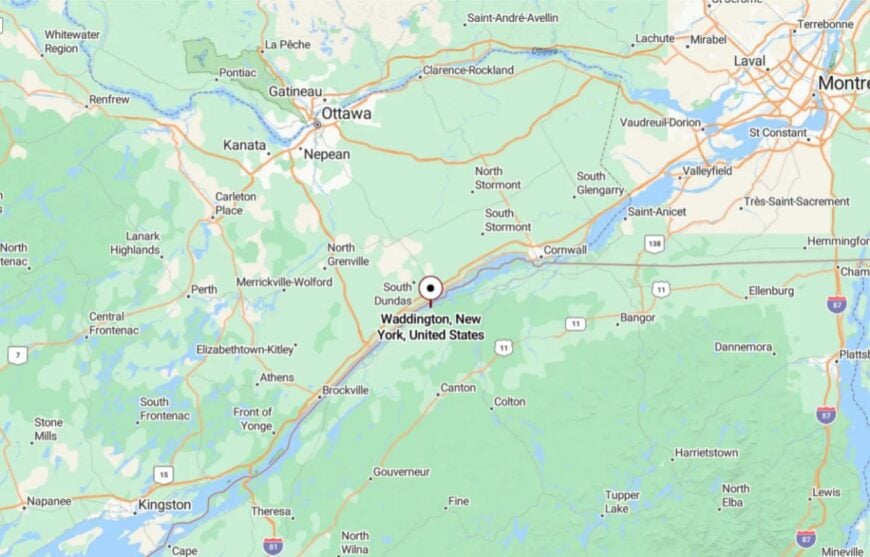
Waddington is in northwest St. Lawrence County along NY-37, about 15 miles west of Massena. The highway curves close to the river, offering glimpses of Canada across the water.
Larger shopping areas are in Massena or Ogdensburg. The space between keeps Waddington calm even in summer.
18. Colton, St. Lawrence County
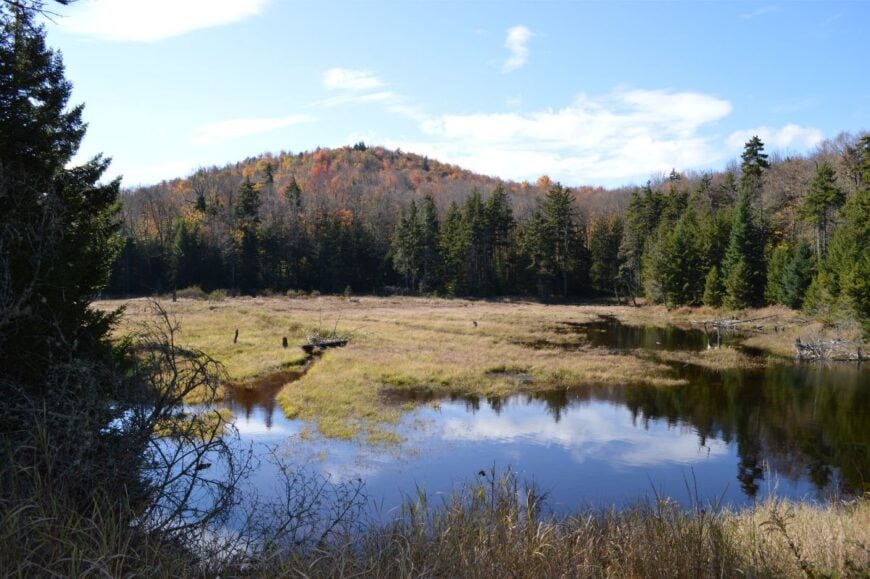
Colton is a small village stretched along the Raquette River, where the water moves as steadily as the pace of life. Fewer than 400 people live here year-round, their homes tucked between wooded hills and riverside lawns.
The historic stone dam in the center hums softly, a reminder of the logging and milling past. Visitors kayak the calm upper stretches of the river, hike nearby Higley Flow State Park, or browse local crafts at summer fairs. The village has just enough shops for essentials, leaving the rest to the quiet of nature.
Crisp autumn mornings fill the air with woodsmoke and the scent of fallen leaves. It’s the kind of place where the seasons aren’t just weather—they’re events.
Where is Colton?
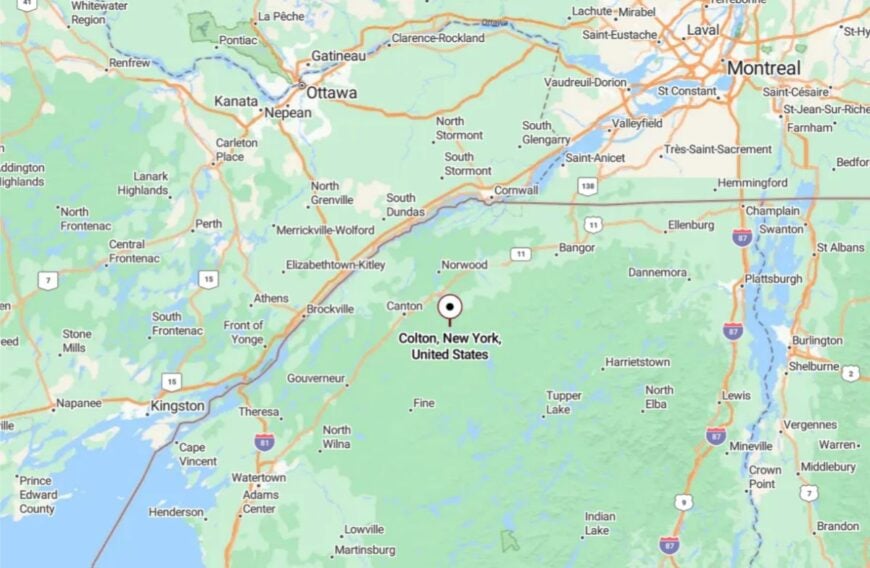
Colton sits in south-central St. Lawrence County along NY-56, about 10 miles south of Potsdam. The drive in follows the Raquette River through wooded valleys.
Larger shopping and services are in Potsdam, a 15-minute trip away. The surrounding forest and riverbanks frame Colton like a natural amphitheater.
17. Paul Smiths, Franklin County
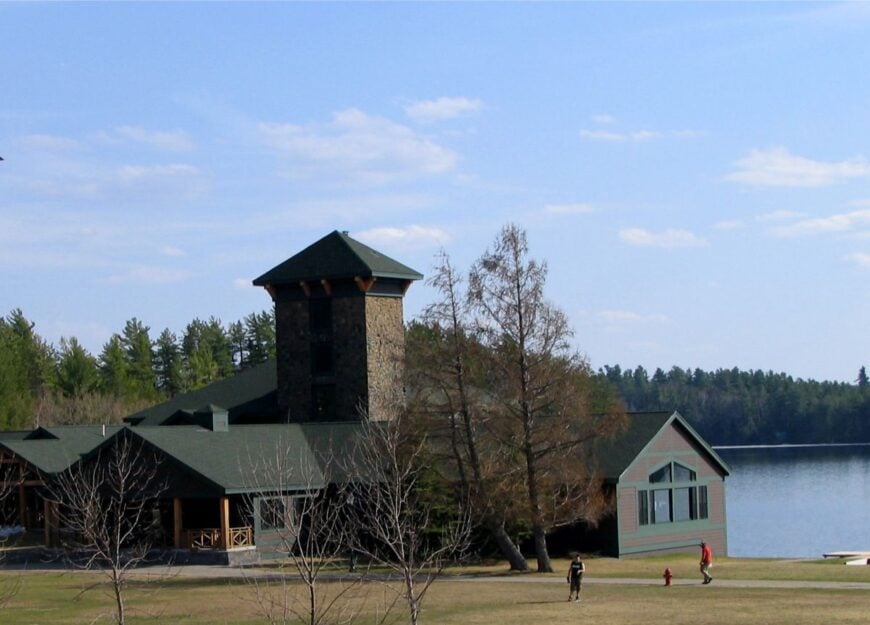
Paul Smiths is a quiet hamlet best known for its historic hotel-turned-college campus and the wild lands that wrap around it. Fewer than 500 residents call it home year-round, with homes and camps tucked into the pines along Lower St. Regis Lake.
Life here revolves around the water—canoeing across glassy mornings, fishing hidden coves, or snowshoeing over the frozen shoreline in winter. The Adirondack Interpretive Center offers miles of peaceful trails through forest and marsh, where the loudest sounds are bird calls and wind in the cattails.
There’s no main street, just a scattering of buildings, trailheads, and docks. Tourism and education share the economic spotlight, though both move at a quiet pace. It’s a place where every path seems to lead deeper into the woods.
Where is Paul Smiths?
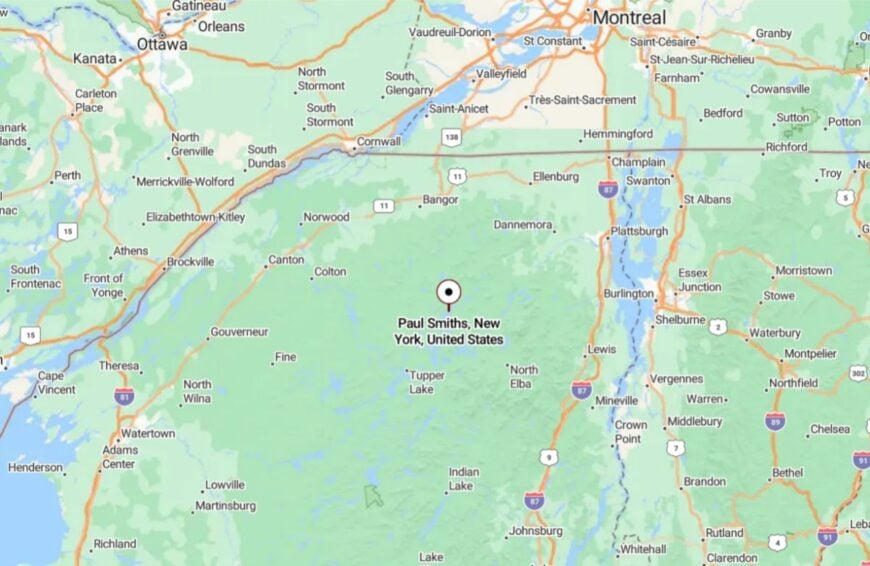
Paul Smiths is in Franklin County, about 12 miles north of Saranac Lake along NY-30. The road passes through miles of Adirondack Forest Preserve and alongside sparkling ponds.
Larger services are found in Saranac Lake, a 15-minute drive away. The forested approach makes it feel like you’ve arrived at a hidden corner of the park.
16. Lake Clear, Franklin County
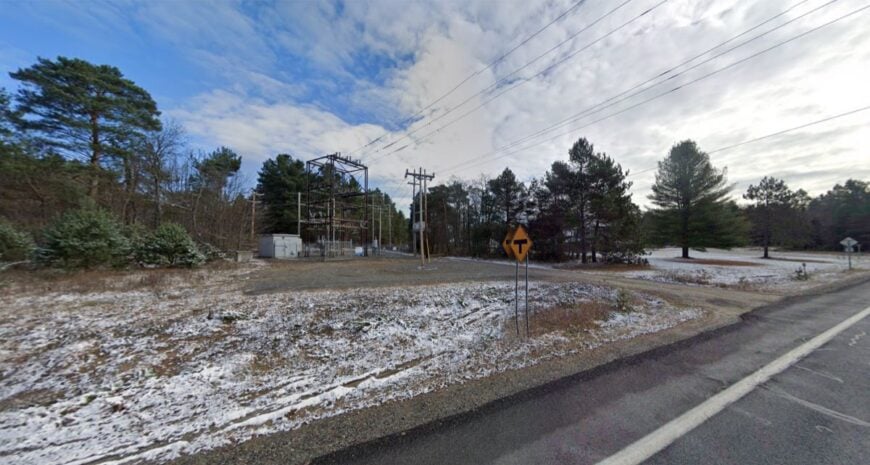
Lake Clear is more of a crossroads hamlet than a traditional village, yet its setting feels remote and restorative. A scattering of homes, camps, and a historic lodge ring the shoreline, with dense pines closing in on the edges.
Residents and visitors fish for trout, paddle across to sandy swimming spots, or ski into the backcountry in winter. The nearby rail trail links it to Tupper Lake and Saranac Lake, but the lake itself remains peaceful.
With no large marina or tourist strip, the view stays uncluttered. Mornings often bring mist that lingers until the sun crests the hills. It’s a place that holds the quiet like a treasured secret.
Where is Lake Clear?
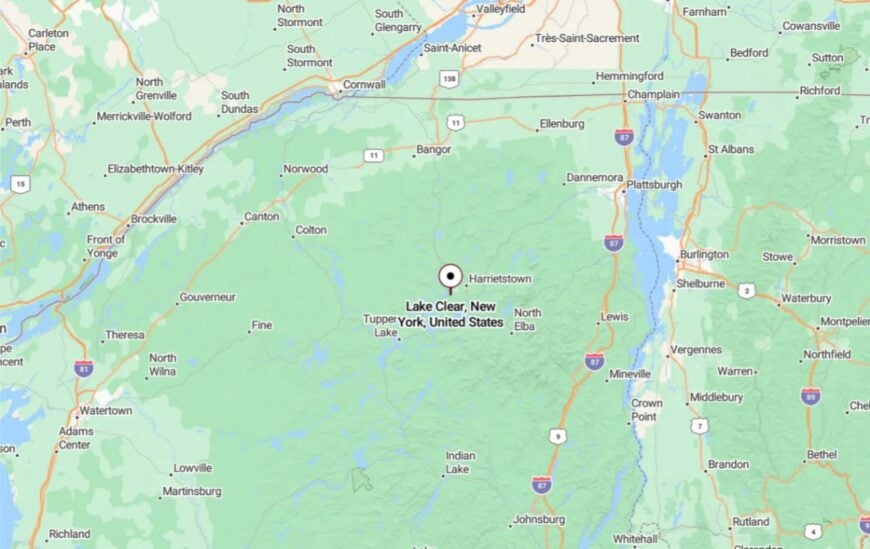
Lake Clear is in Franklin County, about 7 miles west of Saranac Lake along NY-30. The hamlet is surrounded by forest and water, with few through roads.
Larger services are in Saranac Lake, a short but scenic drive away. The approach feels like following a corridor of pines to a hidden shore.
15. Inlet, Hamilton County
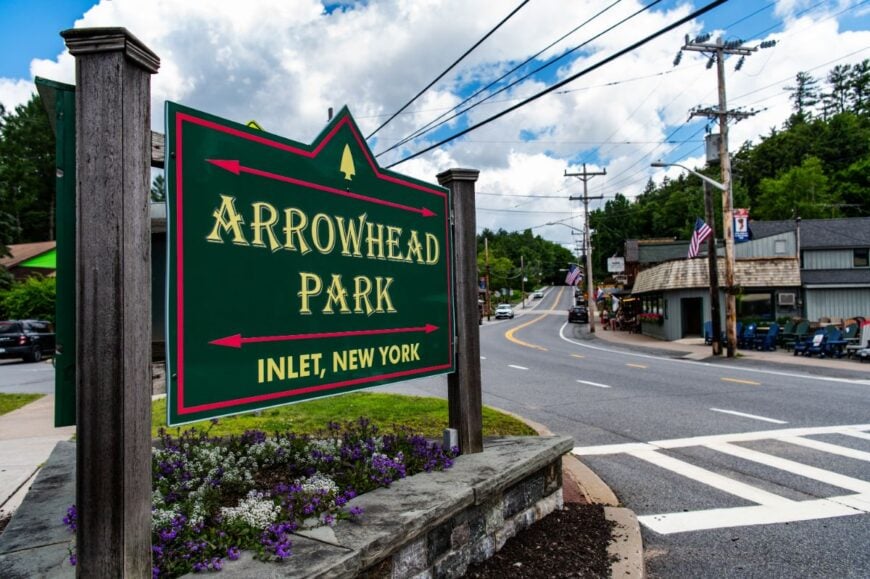
Inlet sits at the head of Fourth Lake in the Fulton Chain, a scenic spot with just a few hundred residents year-round. The village is surrounded by water on one side and mountains on the other, keeping it sheltered from noise and traffic.
Visitors hike Rocky Mountain for panoramic views, explore the local arts center, or boat to quiet picnic spots on the chain. The small downtown is walkable, with family-run shops and cafés in historic buildings.
Tourism drives much of the economy, but strict zoning preserves the village’s intimate feel. Early mornings are filled with the sound of gulls and gentle lapping waves. Inlet feels like a harbor for both boats and the soul.
Where is Inlet?
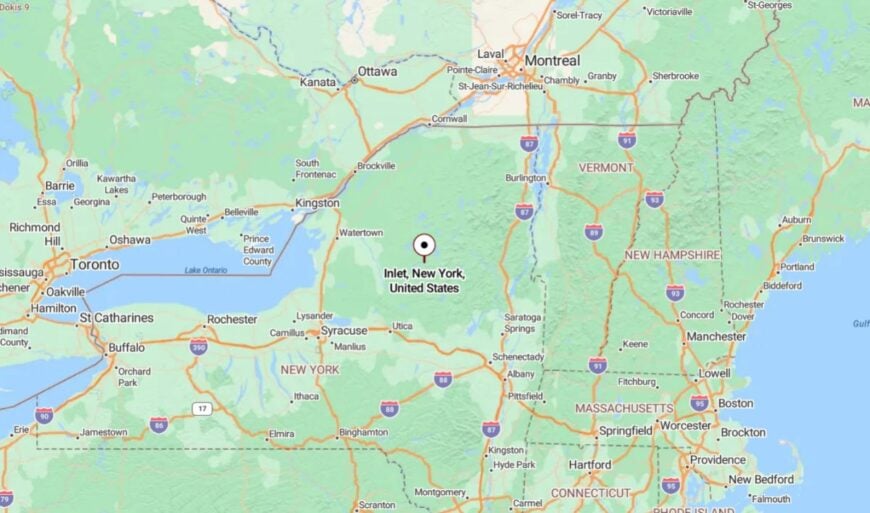
Inlet is in Hamilton County along NY-28, about 10 miles northeast of Old Forge. The route in hugs lakes and passes trailheads, setting the tone for arrival.
The nearest major supermarket is back in Old Forge, ensuring little extra traffic here. The town’s position at the end of the chain keeps it peaceful even in summer.
14. Speculator, Hamilton County
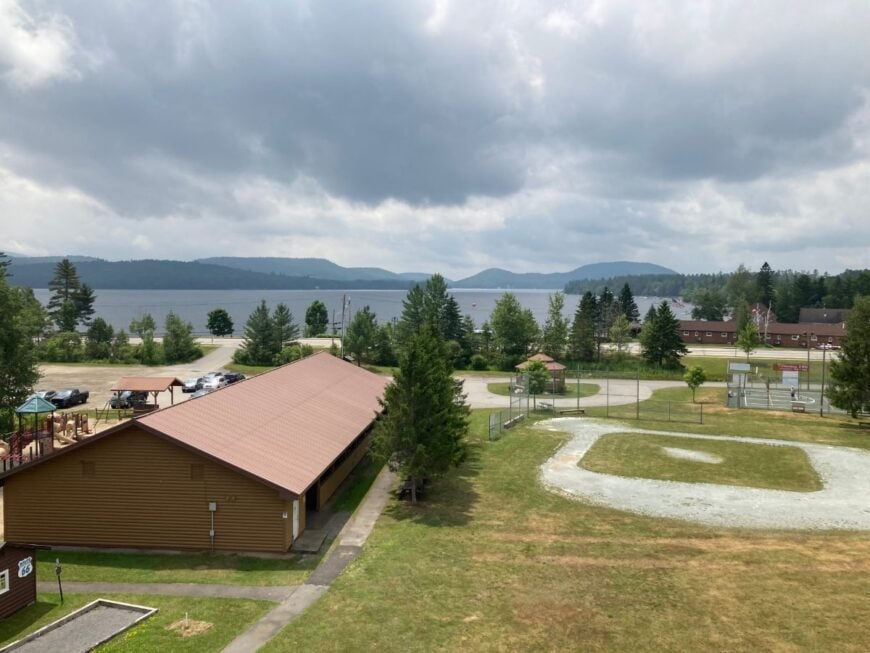
Speculator is known as the “Gateway to the Adirondacks,” but its small size keeps it feeling personal and secluded. Fewer than 400 people live here, with the rest arriving seasonally to enjoy Lake Pleasant and the surrounding wilderness.
Boating, hiking, and snowmobiling are big draws, yet the town center remains quiet after dark. The local economy blends tourism with small businesses that serve both locals and visitors.
Miles of forest roads lead to trailheads, waterfalls, and old logging sites. In autumn, the hills burn with color reflected in the lake. It’s a place where the natural beauty is never out of sight.
Where is Speculator?
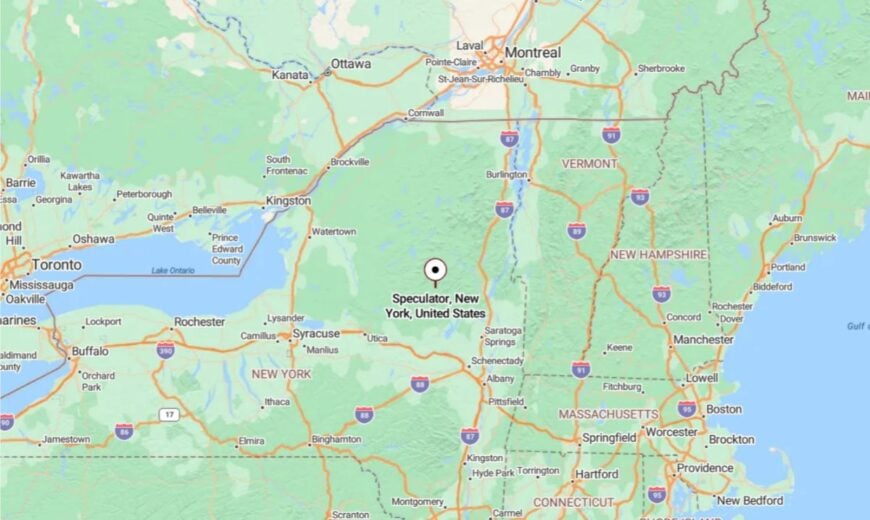
Speculator is in Hamilton County along NY-8 and NY-30, about 50 miles northwest of Saratoga Springs. The drive in passes through long stretches of forest and around several small lakes.
The nearest larger town is Northville, about 40 minutes away. Arriving feels like easing into a deep forest clearing.
13. Indian Lake, Hamilton County
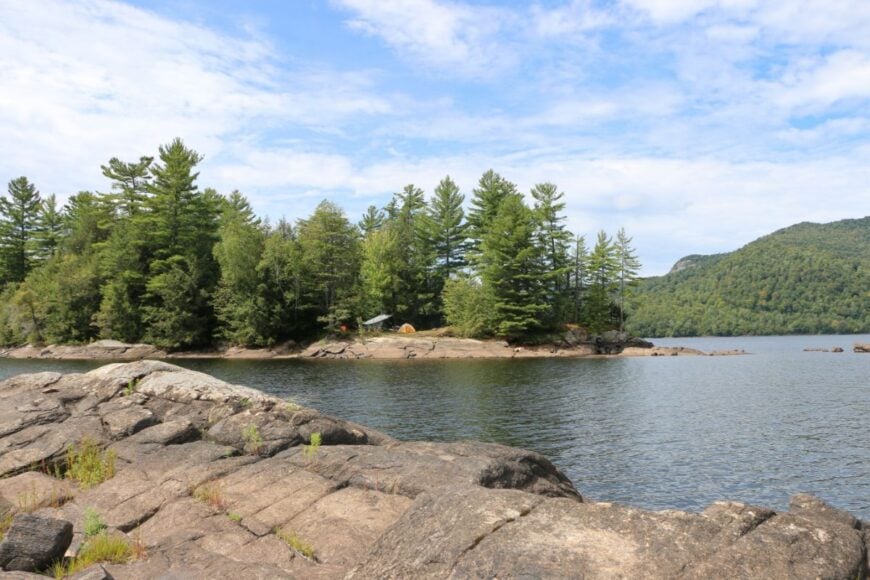
Indian Lake is both a town and a hamlet, spread across a vast stretch of the central Adirondacks. Fewer than 1,500 residents live here year-round, with the hamlet itself resting on the shores of its namesake lake.
Activities revolve around paddling, fishing, and hiking into the Siamese Ponds Wilderness. The main street holds just enough to keep you stocked between adventures, with a couple of diners, a general store, and a gear shop.
Logging and tourism share space in the local economy. Early mornings often bring a soft fog that blurs the lake and mountains into one. It’s a community where the wilderness begins at the edge of your lawn.
Where is Indian Lake?
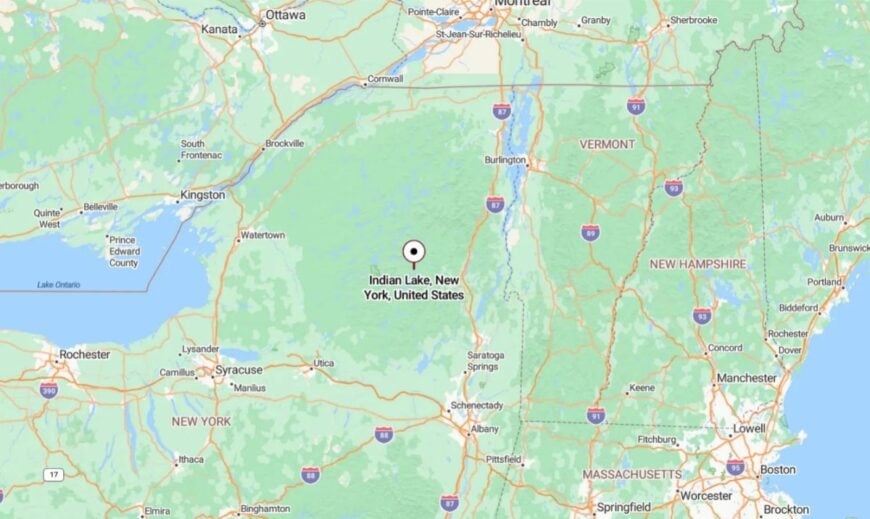
Indian Lake is in Hamilton County along NY-28, about 40 miles north of North Creek. The road in is lined with forest and occasional mountain vistas.
The nearest supermarket is nearly an hour away. The long, scenic approach makes the arrival feel like an earned reward.
12. Piseco, Hamilton County
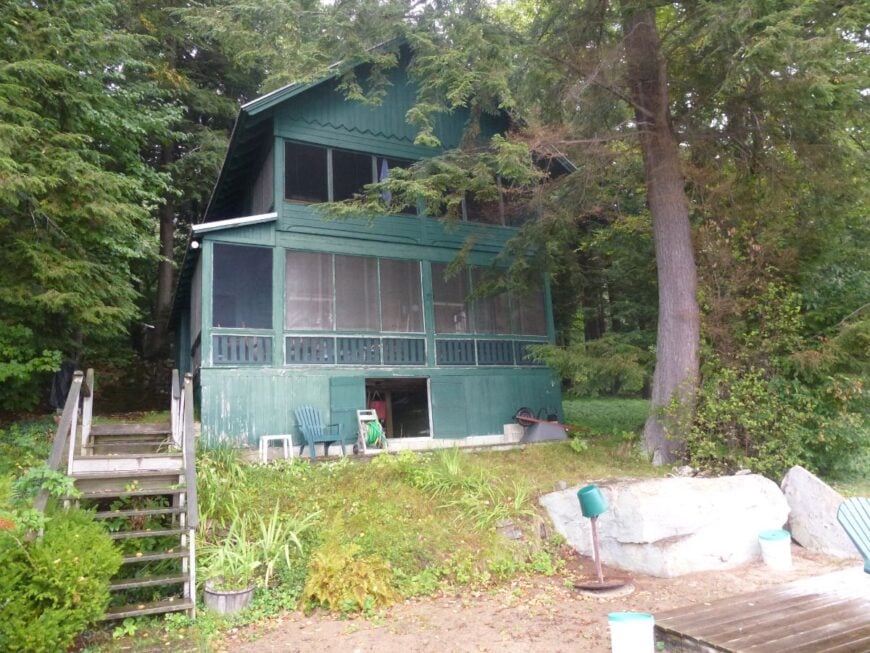
Piseco is a scattering of camps and year-round homes along Piseco Lake, where the shoreline is mostly undeveloped and framed by forested slopes. With fewer than 400 residents, the pace here is set by the water and the weather.
Boating, fishing, and hiking the Northville-Placid Trail are popular, while winter brings ice fishing and snowshoeing. There are no large stores—just a couple of lodges and a seasonal campground.
The lake is quiet enough that paddle strokes can be heard from shore to shore. Evenings bring the scent of pine and woodsmoke drifting together. Piseco is the kind of place where the horizon feels unbroken.
Where is Piseco?
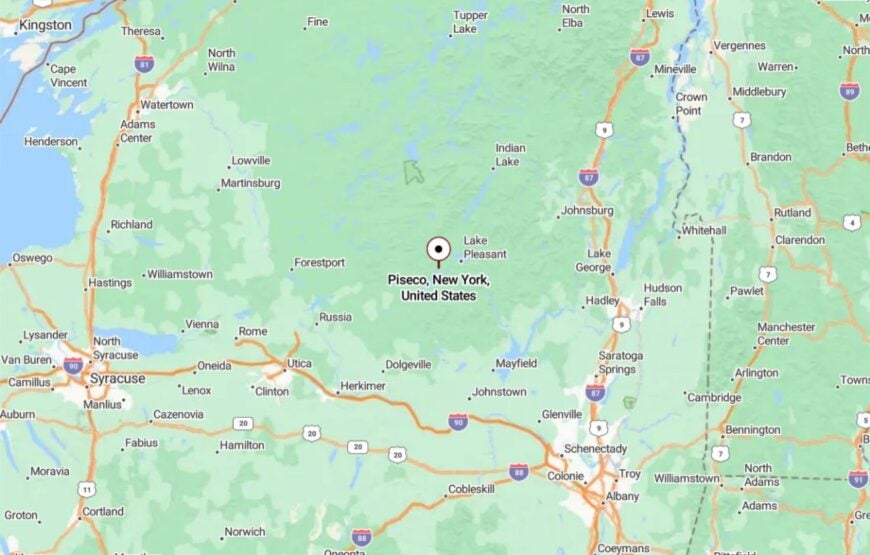
Piseco lies in southern Hamilton County along NY-8, about 20 miles west of Speculator. The approach winds through forest and along streams, with no major towns nearby.
The nearest large grocery store is in Speculator. Once you arrive, the quiet feels as deep as the lake itself.
11. North River, Warren County
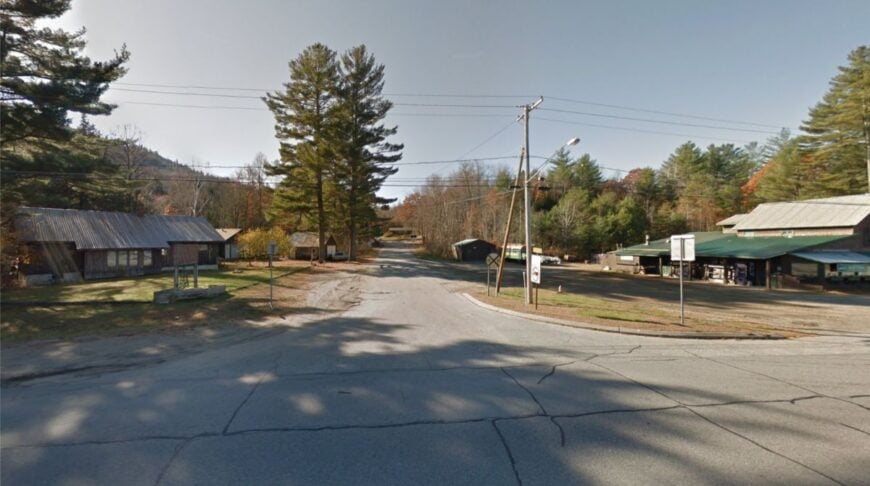
North River is a hamlet on the upper Hudson River, famous for its garnet mines and its wild, unspoiled setting. Fewer than 300 people live here, spread along the river and into the surrounding hills.
Whitewater rafting, hiking, and visiting the garnet mine are favorite activities, but most days are still and unhurried. There’s no commercial center—just a scattering of homes, lodges, and trailheads. The economy leans on tourism and small-scale forestry.
Autumn paints the valley in vivid color, and the sound of the Hudson here is the low rush of rapids, not the roar of highways. It’s a place that feels as old and steady as the mountains around it.
Where is North River?
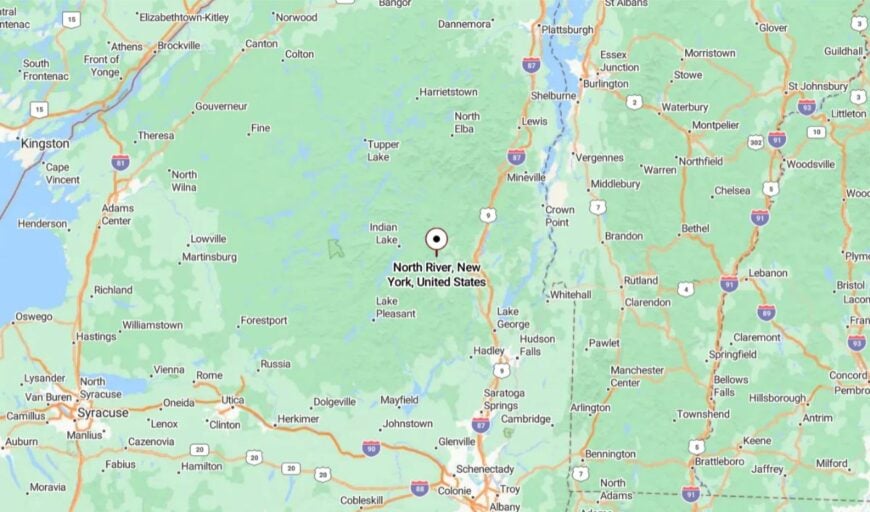
North River is in northern Warren County along NY-28, about 15 miles north of North Creek. The road in hugs the Hudson River’s upper stretches.
The nearest services are in North Creek, a 20-minute drive south. The river and surrounding peaks form a natural enclosure, adding to its sense of retreat.
10. Cranberry Lake, St. Lawrence County
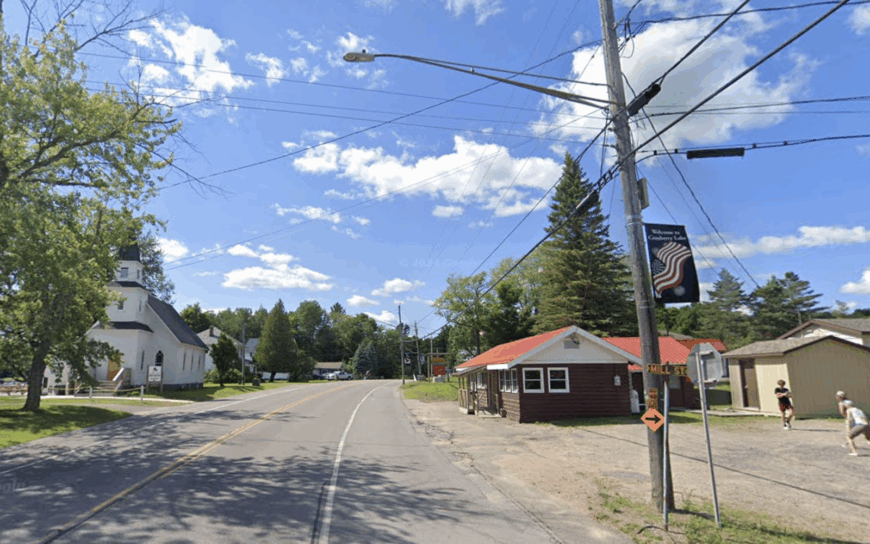
Cranberry Lake claims fewer than 700 full-time residents, keeping neighborly ties genuine and traffic nearly nonexistent. Days are filled with paddling cedar-lined coves reachable only by canoe, hiking the 50-mile Cranberry Lake Trail, or casting for brook trout in the Oswegatchie headwaters.
Seasonal outfitters, a lone general store, and small forestry crews form the modest economic backbone, while most locals craft livelihoods around guiding and caretaking. A full 50,000 acres of state forest wrap the hamlet, eliminating room for sprawl and keeping the night sounds limited to loons and barred owls.
Spacious waterfront parcels still top an acre, so cabins enjoy generous buffers of balsam and birch. With no chain restaurants, no stoplights, and sporadic cell coverage, the lake feels worlds away from Route 81’s bustle.
Where is Cranberry Lake?
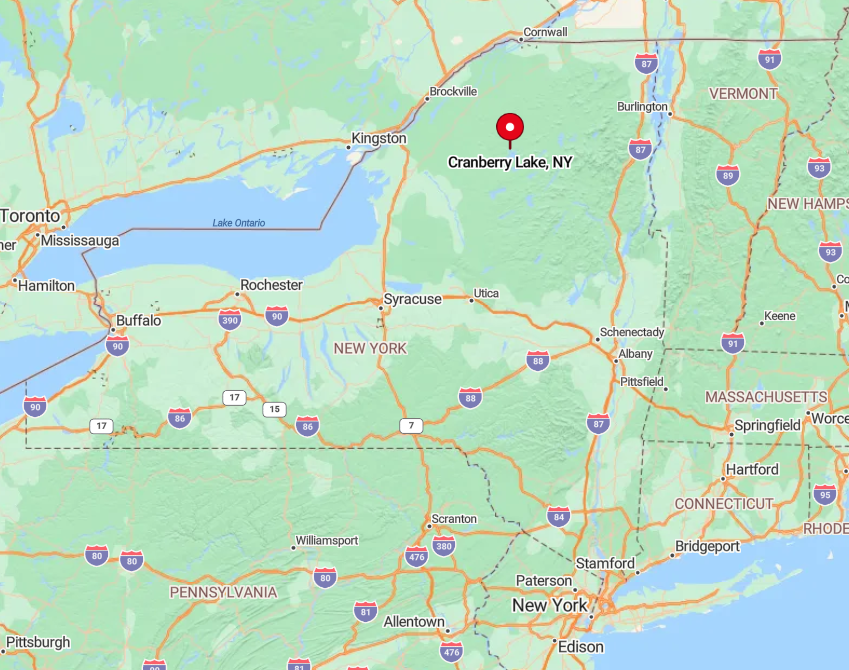
The hamlet sits on the western edge of the Adirondack Park, about 35 miles southeast of Gouverneur and well north of the high-peak corridor. Only two paved roads reach the village, both curving through miles of state forest that act as a natural gate.
Distance from major highways, along with limited winter plowing, reinforces its quiet reputation. Drivers usually arrive via NY-3, while paddlers often slip in from Lows Lake through a chain of remote ponds and carries.
9. Blue Mountain Lake, Hamilton County
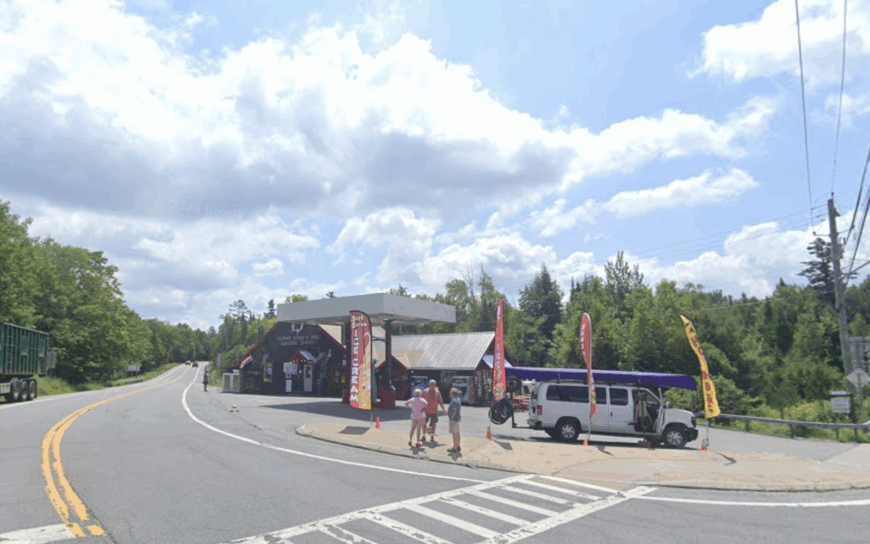
Blue Mountain Lake supports a year-round population under 350, allowing every sunrise to feel like a private showing. Visitors tour the Adirondack Experience museum, climb Blue Mountain’s fire-tower trail, or drift past vintage boathouses in classic wooden launches.
A handful of lodges, a small marina, and artisan galleries support local employment, yet commercial footprints remain light because almost all shoreline is protected by state or private conservation easements.
The absence of through-roads forces traffic to end at the water, preserving a postcard hush even on busy summer weekends. Historic camps rest on roomy lots that buffer lake noise and preserve original views of surrounding peaks. At night the only glow comes from campfire embers and the Milky Way arcing overhead.
Where is Blue Mountain Lake?
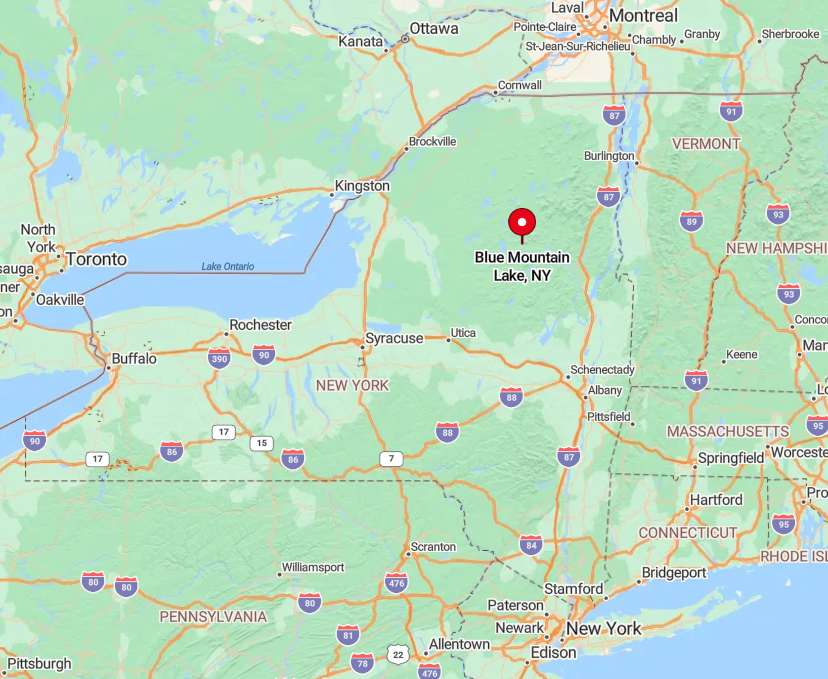
The village is tucked where NY-28N meets NY-30, roughly an hour from the nearest supermarket in Old Forge. Mountain ridges box the valley, so radio and cell signals fade quickly as travelers descend toward the shoreline.
Winter access can narrow to a single plowed lane that wanders beside frozen inlet marshes. Most guests arrive by car, though floatplanes occasionally drop anglers on the glassy water when ice is out.
8. Long Lake, Hamlet of Long Lake
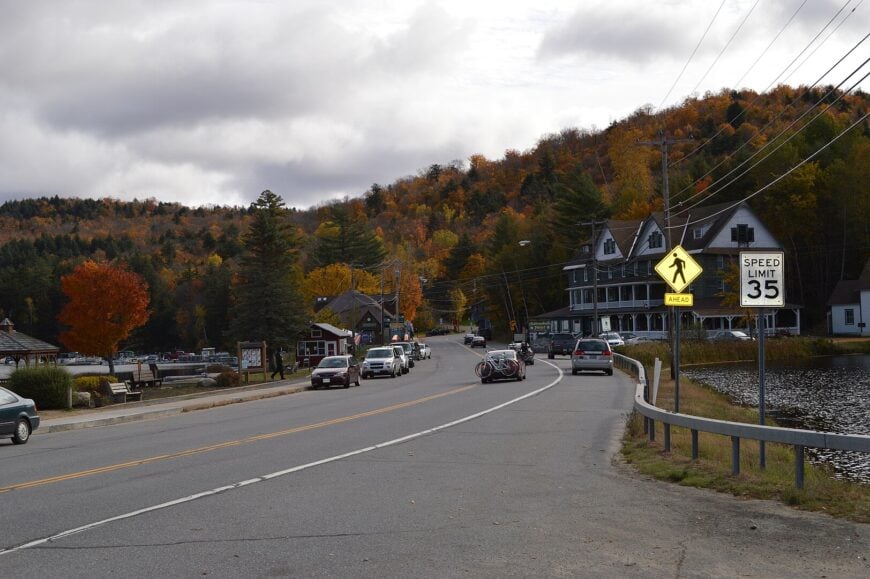
Only about 700 residents call the hamlet of Long Lake home, even though the lake itself runs a scenic 14 miles from end to end. Popular activities include touring by pontoon boat, hiking Owl’s Head Mountain, and visiting the little-known Sabattis Station site where trains once delivered Manhattan elites to remote camps.
A tiny school, two outfitters, and a pair of family-run motels anchor employment while strict zoning caps housing density to fewer than 100 homes per square mile. The nearest big box store sits 30 miles away, so weekly supply runs feel like expeditions and keep impulse developments at bay.
Cabins tuck behind mixed hardwood stands on multi-acre tracts, preserving shoreline sightlines. Nightfall brings deep silence broken only by coyotes crossing the old rail grade.
Where is Long Lake?
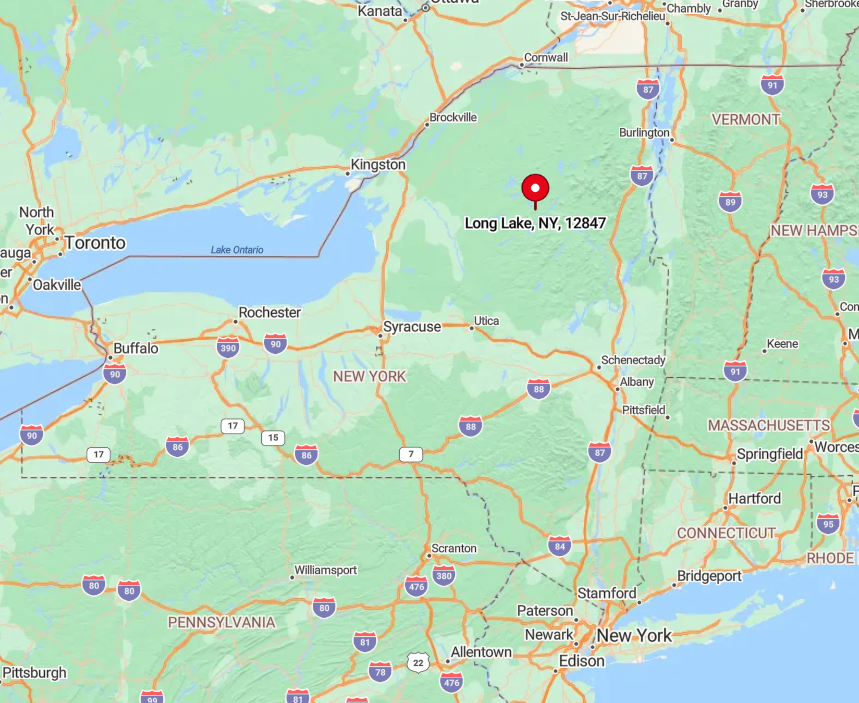
The hamlet straddles NY-30 almost midway between Tupper Lake and Blue Mountain Lake, yet surrounding wild forests absorb any through-traffic hum. Distance from interstates and limited public transit mean access is largely self-reliant.
Winter visitors often strap skis to reach remote trailheads when secondary roads close. Small aircraft can land at the turf airstrip south of town, but most travelers simply follow NY-30 until pavement meets water.
7. Raquette Lake, Hamilton County
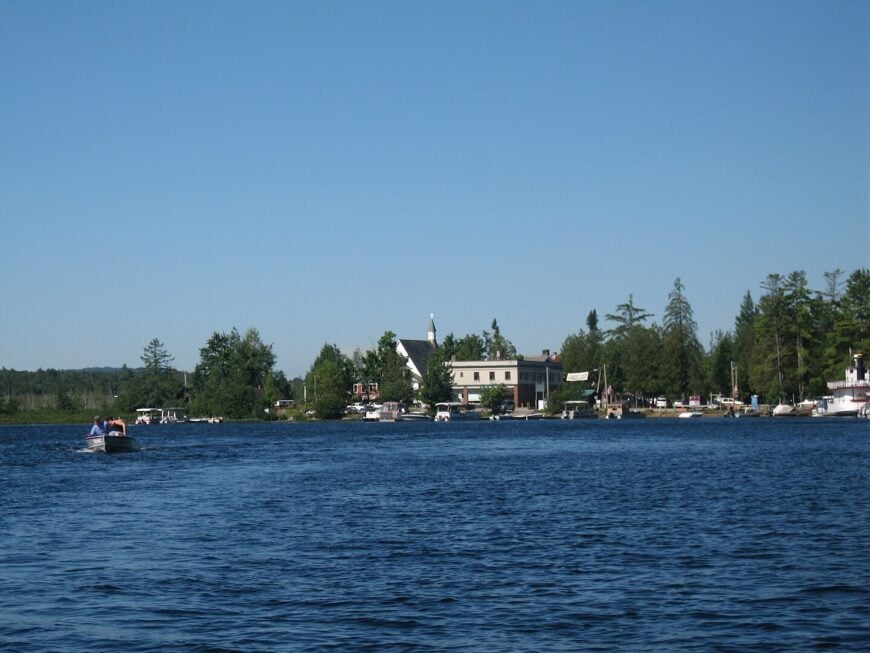
Raquette Lake holds only about 100 year-round residents, yet its shoreline is dotted with storied great camps once owned by Vanderbilt and Durant heirs. Today guests kayak secluded bays, tour Saint William’s church on an island, or join the Moonlighter’s soft-serve boat that circles coves with ice cream in summer.
A single year-round general store, seasonal tour boat, and cottage caretaking supply most local jobs, leaving the horizon free of franchise signage. Vast tracts of forever-wild land block road expansion, so many camps remain boat-access only, amplifying privacy.
Public lands ensure that nearly every bay looks as it did a century ago. Even summer nights retain a cathedral stillness broken only by distant loon calls.
Where is Raquette Lake?
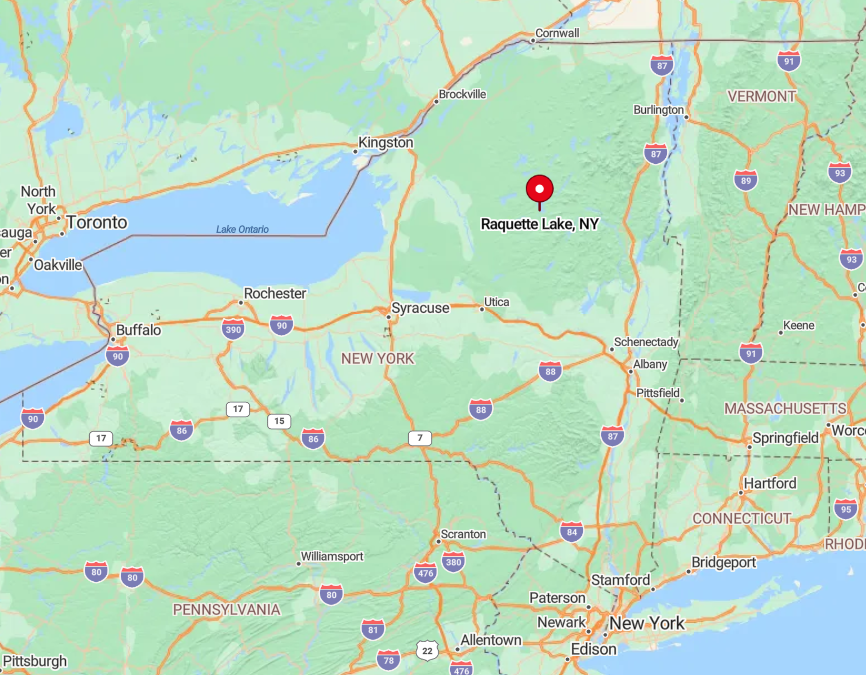
The settlement lies at the terminus of County Route 2, roughly 16 miles from the hamlet of Inlet, with water and forest hemming in the final five miles. Limited road frontage and a thin power grid keep development sparse.
Visitors park at the village dock, then shuttle groceries to boats for the last leg of the journey. Winter travelers often rely on snowmobiles that trace a groomed corridor across the frozen lake.
6. Star Lake, St. Lawrence County
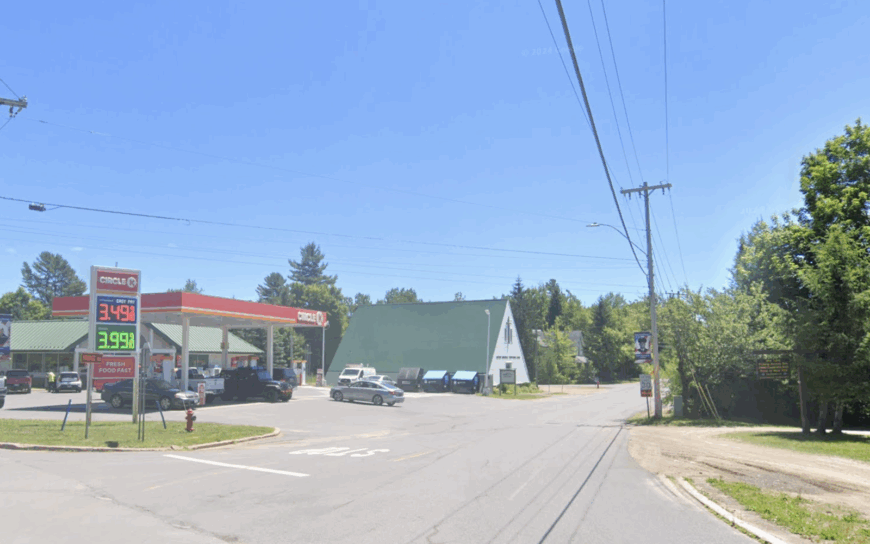
Star Lake’s population hovers near 500, the legacy of an iron-mining era that faded decades ago and left wide lots and sturdy company houses. Today residents fish bass beneath granite outcrops, cycle quiet County Route 61, or kayak to the back bay where pitcher plants thrive unbothered.
Employment now centers on a health campus, small forest-product outfits, and seasonal tourism. Adirondack Park holdings encircle the village, buffering it from outside development and major traffic.
Large wooded parcels give homes breathing room and shield porch lights from one another. Even midsummer evenings feel hushed enough that bullfrogs provide the loudest commentary.
Where is Star Lake?
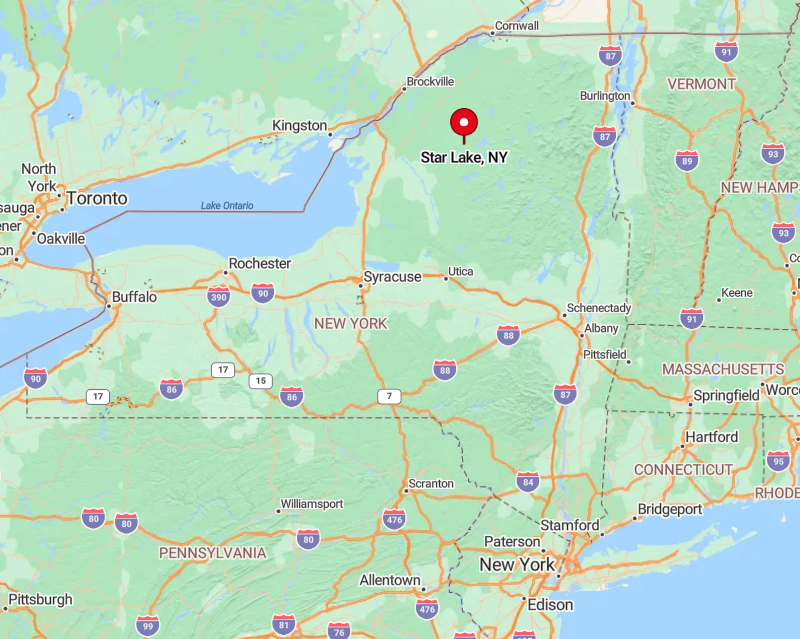
The village sits along NY-3, yet dense state forest stretches for miles in every direction, acting as a living sound wall. The closest four-lane highway lies more than an hour west in Watertown, discouraging casual visitors.
Winter storms often slow travel over the foothills, reinforcing the area’s tucked-away vibe. Most approach by car while cyclists on the Adirondack Loop treasure it as a quiet resupply point.
5. Brantingham Lake, Lewis County
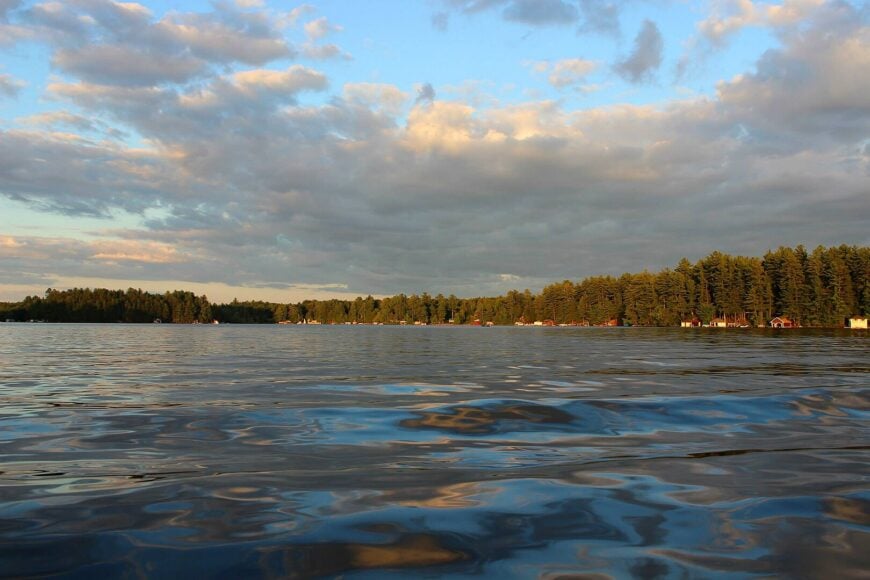
In both summer and winter Brantingham Lake records a substantial seasonal spike above its 400± permanent residents, residing on a network of a few hundred lakefront lots, hidden beneath towering white pines.
Locals spend summers swimming, jet-skiing, waterskiing, or cruising on the clean, spring-fed lake, riding the extensive ATV trail system, or teeing off at the popular 18-hole golf course that dates to 1910.
Snowfall averages over 200 inches, so the winter community is taken over by hundreds of snowmobilers, many coming from over a hundred miles away to enjoy the free groomed trails.
Two year-round restaurants and a few retail services form the principal businesses. The nearest highway (NYS Route 12) lies about 10 miles away, keeping noise and fast food firmly out of earshot. As a result, evenings often belong only to wind in the white pines and the friendly calling of loons.
Where is Brantingham Lake?
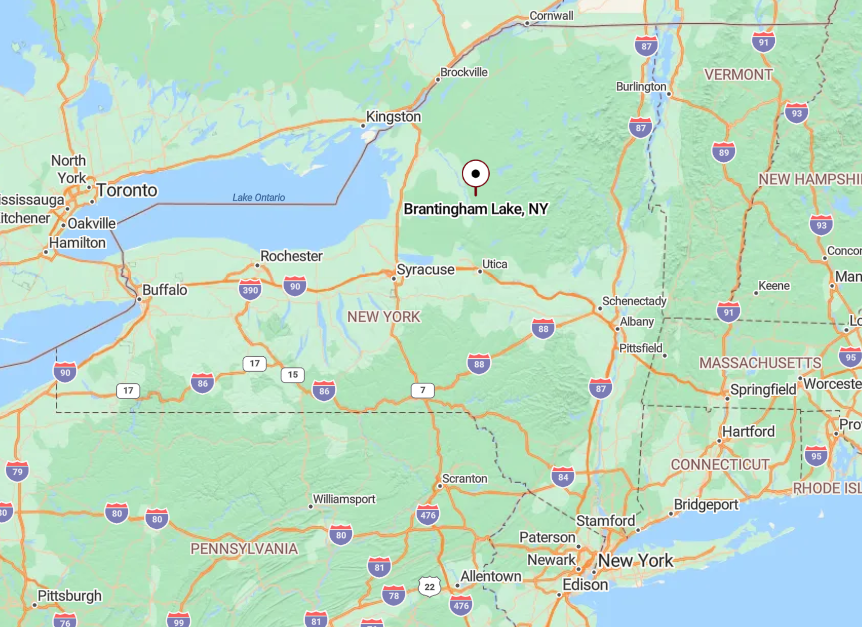
The community sits within the western edge of the Adirondack Park, accessible by NYS Route 12, roughly between Boonville and Lowville. One reason for Brantingham Lake’s popularity is that it is the closest Adirondack lake to western New York (Syracuse, Rochester, Buffalo, etc.) urban centers.
Elevation, dense forests and lake-effect snows make it feel more remote than its mileage suggests. Unlike many other small upstate New York communities, it is not on the way to somewhere else. Instead, all of the people at Brantingham are there because they have purposefully chosen to take the road in to enjoy that unique community.
With a local tower, cell reception is good. Walmart, Tops, and numerous other retail outlets and golf courses are less than 20 miles away.
4. Wanakena on the Oswegatchie River
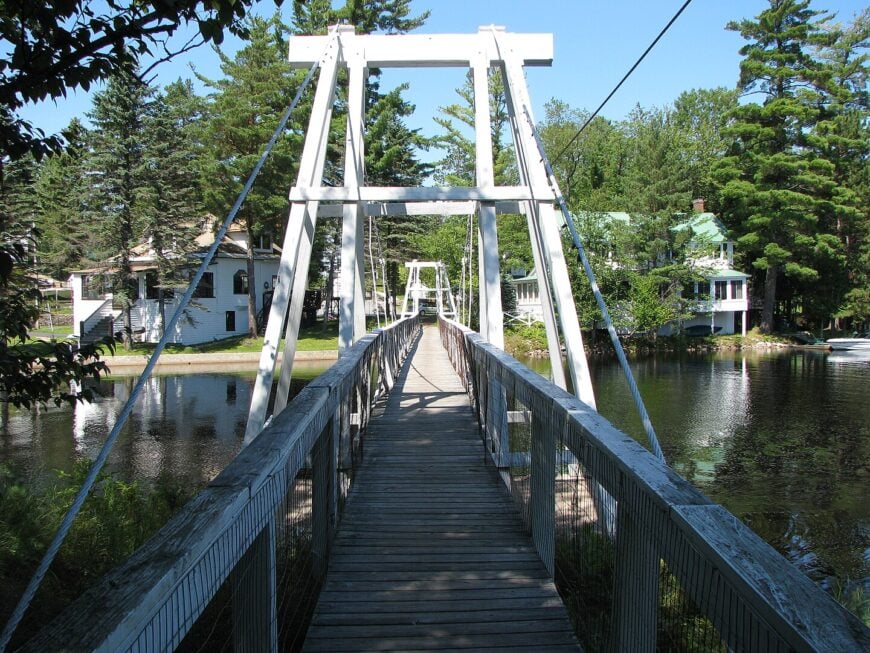
Fewer than 100 residents live in Wanakena, where restored Adirondack cottages stand on spacious grounds along the Oswegatchie’s west branch. Days revolve around fishing deep river pools, strolling across the historic wooden-truss footbridge, or enjoying impromptu concerts at the tiny lakeside amphitheater.
Employment is limited to a seasonal café, a student field station for SUNY ESF, and property-management gigs for absentee camp owners. Roughly 75 percent of the surrounding land is state-owned wilderness, boxing the hamlet in a green cocoon.
The absence of a conventional main street keeps visitor numbers low and traffic slower than the river current. Nights settle into complete darkness save for lanterns hung on porch hooks.
Where is Wanakena?
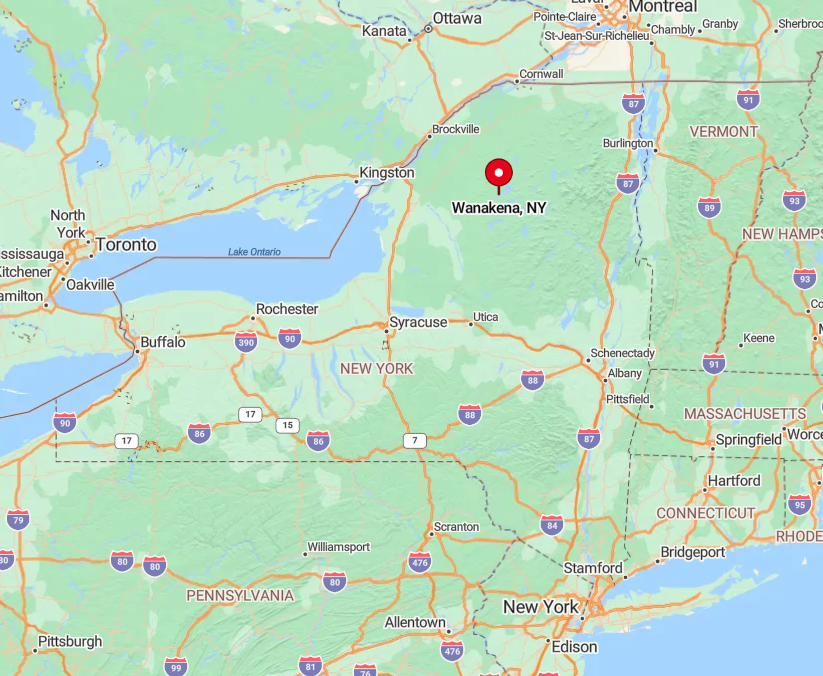
Wanakena lies at the west end of Cranberry Lake, reached by turning off NY-3 onto a spur that ends abruptly at the river. Forest service roads branch beyond but are often gated, so the hamlet enjoys zero through-traffic.
Seclusion is heightened by the fact that the only bridge is for foot traffic, forcing vehicles to park on the village edge. Paddlers often glide in from Inlet Flow, making arrival part of the adventure.
3. Redwood on Butterfield Lake, Jefferson County
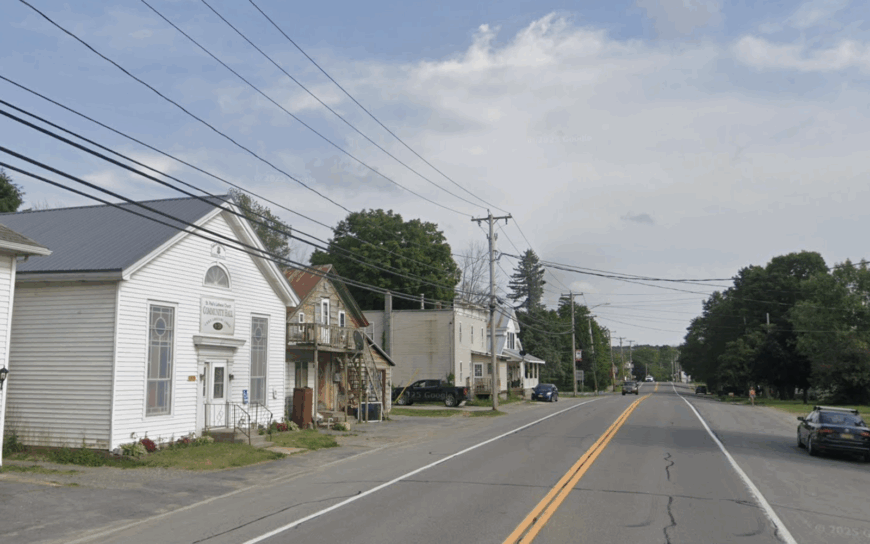
Redwood counts fewer than 600 residents, with homes sprinkled amid rolling farmland where maples meet cedar swales. Locals cast for northern pike on Butterfield Lake, explore the Pitch Pine Barrens Preserve, or grab fresh cheese curds at the unmarked dairy farm south of town.
The economy orbits around family agriculture, seasonal fishing camps, and small-scale sawmills. Dense cedar groves and a shoreline conservation easement screen cottages from the nearest state route, preserving a curtain of silence.
Lots average an acre or more, so yard games rarely bother a neighbor. Even peak season sees more herons than motorboats on the glassy water.
Where is Redwood?
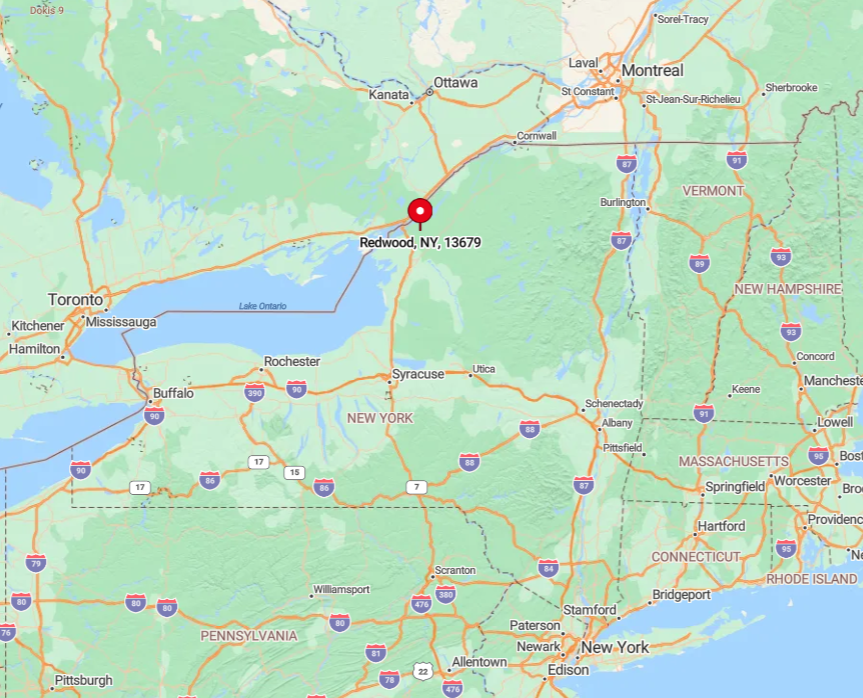
The hamlet sits just east of the St. Lawrence River corridor, roughly 25 minutes from Clayton, yet ridges of mixed forest mute any river traffic hum. State Route 37 skirts to the west, leaving local lanes blissfully quiet.
Visitors generally exit Interstate 81 at Theresa and wind ten miles of back roads before farmland gives way to lake reflections. A modest public launch accommodates fishing rigs, though many guests arrive by kayak through a chain of marshy creeks.
2. Childwold near Massawepie Lake
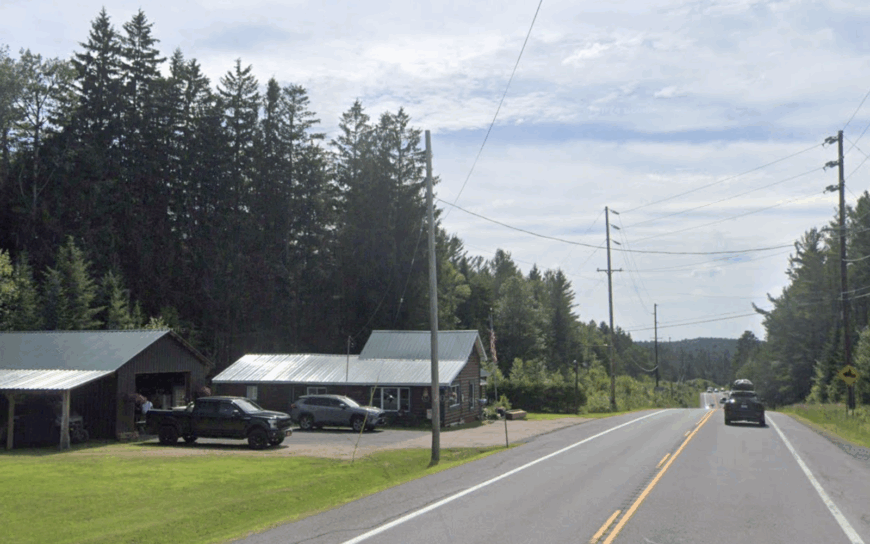
Childwold maintains a population below 100, spread across a patchwork of five-acre tracts stitched by sandy lanes. Residents enjoy birding the rare tamarack bogs, paddling Massawepie Lake before scouts arrive each June, and hiking to secluded Bear Pond where pitcher plants bloom.
Economic activity is minimal, limited to a seasonal campground, maple-syrup producers, and caretaking for historic lodges. The closest village sits 15 miles away, making quick errands anything but quick.
Off-grid cabins outnumber wired homes, ensuring nights stay dark enough for meteor showers to steal the show. Morning traffic typically consists of a single mail carrier and the occasional logging truck.
Where is Childwold?
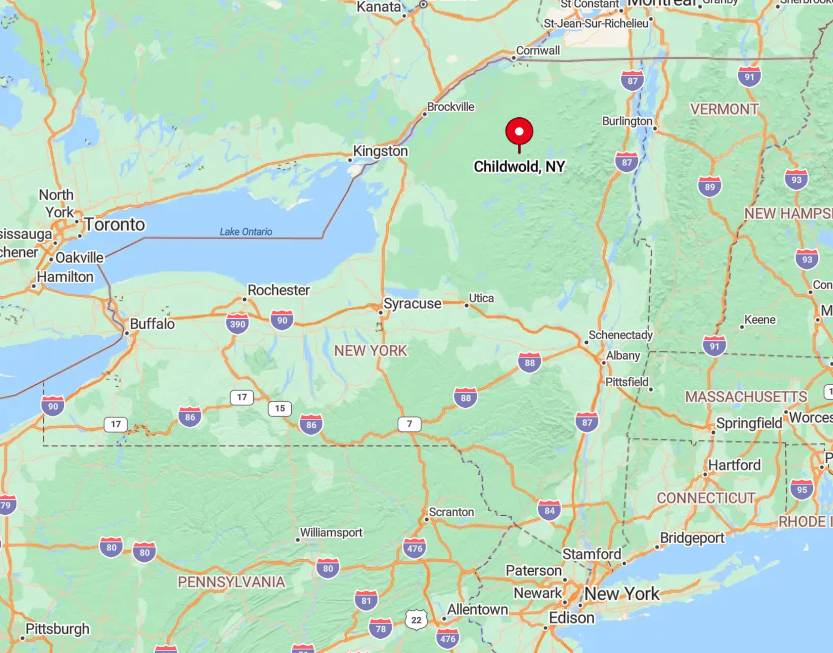
Childwold lies south of Tupper Lake on County Route 62, a road that dead-ends at Massawepie Scout Reservation gates. Thick spruce wetlands flank both sides, muffling any hint of civilization.
Visitors must plan fuel stops carefully, as the nearest gas pump is back on NY-30. Winter access often requires high-clearance vehicles or snowshoes when lake-effect storms roll through.
1. Coreys on Upper Saranac Lake
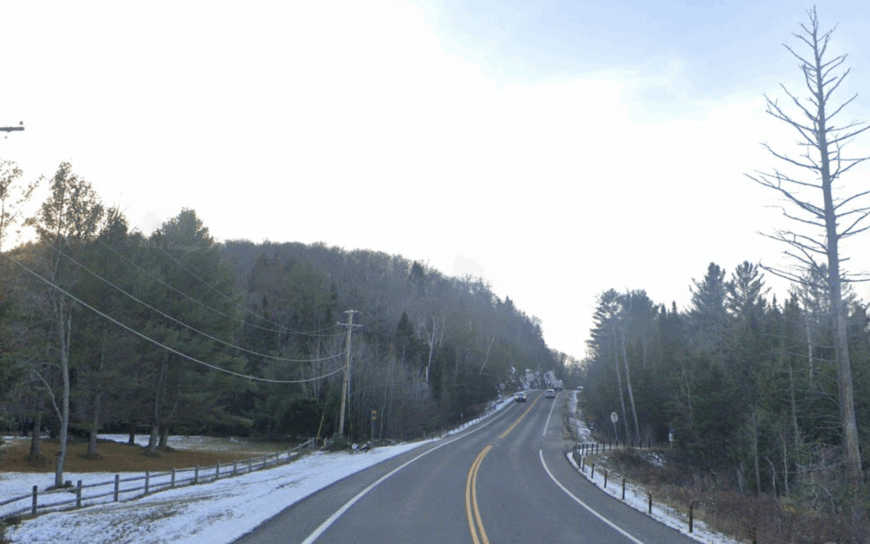
Coreys hosts little more than a dozen full-time residents, yet its shoreline is marked by century-old boathouses fronting secluded camps tucked behind tall hemlocks. Paddlers slip into Stony Creek Ponds or cross the Indian Carry portage to reach Middle Saranac, while hikers set out from here toward the rugged Seward Range.
Local income comes mostly from private caretaking, research posts at the nearby Adirondack Ecological Center, and guide services that specialize in long backcountry routes. Conservation easements keep development capped, so the hamlet feels as spare as its gravel road.
Even in summer, the traffic is more deer than delivery vans. At night, the silence runs deep, broken only by loon calls or the crunch of boots on the portage trail.
Where is Coreys?
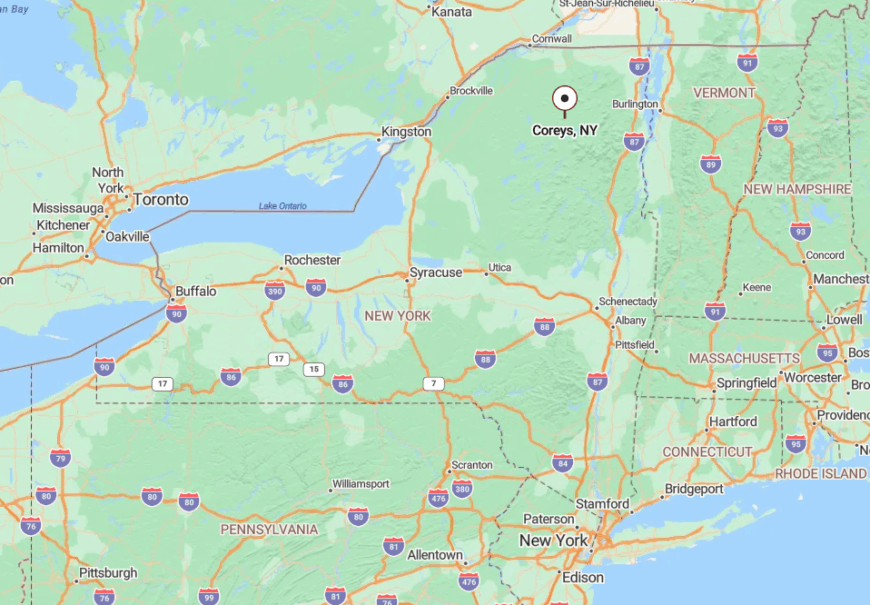
Coreys lies south of Upper Saranac Lake, reached by Corey’s Road (Ampersand Road), which turns off NY-3 just west of the village of Saranac Lake. The road dead-ends at trailheads for the Seward Range and ponds that feed into the Raquette River.
There are no services in the hamlet itself; the nearest gas and groceries are back in Saranac Lake. Most arrivals come by car to the trailhead, or by canoe across South Creek, which links directly to Upper Saranac. The approach ensures Coreys remains one of the Adirondacks’ quietest corners.


